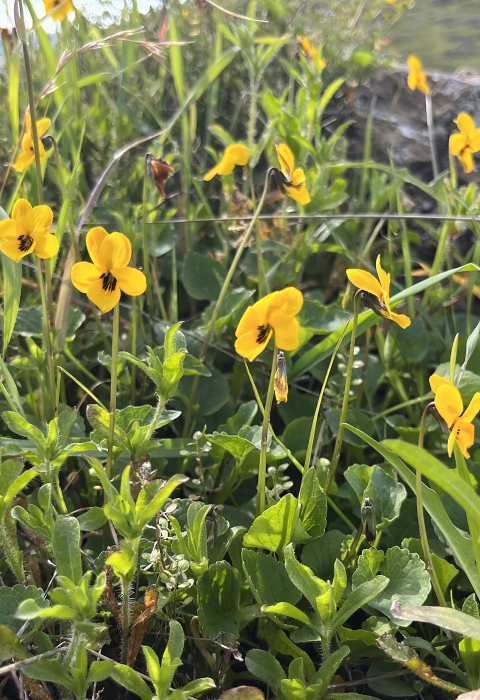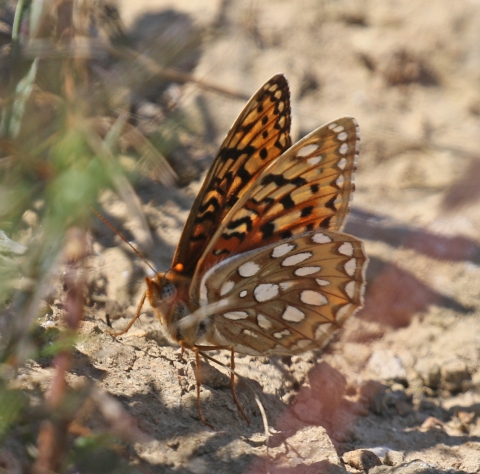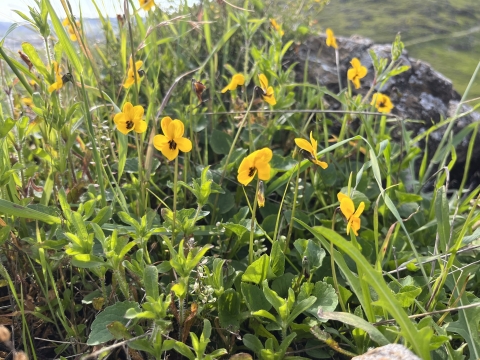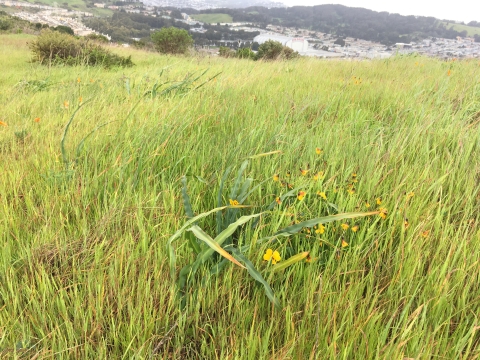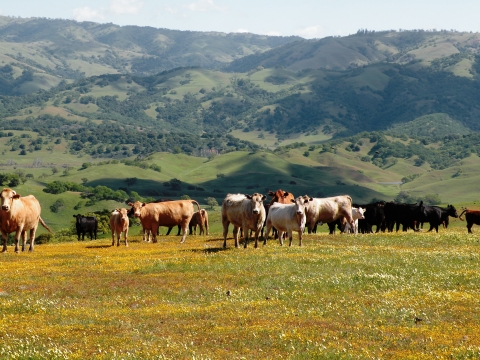It’s a sunny, late-spring afternoon on the San Francisco Peninsula. The vivid yellow blooms of the California golden violets have faded, their petals curled on the ground near their withering stems, its spring-time energy spent. But new life has come to share space with the old. Just an inch from the violet’s drying leaves, a striking orange and black butterfly tests the ground with her abdomen. She is not a Monarch, but a much rarer butterfly—a callippe silverspot. As she gently probes the ground, she is searching for pockets under the natural debris to lay her eggs, one by one. In just one week, her tiny eggs will hatch into equally tiny caterpillars. Then, together with the resting violets whose life cycle they mirror, they will sleep until next spring.
Like many butterflies, the relationship the endangered callippe silverspot has with its golden violet host plant is irreplaceable. Host plants provide shelter and food for the eggs and growing caterpillars of particular butterfly species.
“Many butterflies have a number of species they use as larval host plants, but some butterflies, like the callippe silverspot, can only use a single species,” said Joseph Terry, senior wildlife biologist at the Sacramento Fish and Wildlife Office. “Without the California golden violet, the callippe silverspot would perish.”
With just four populations of callippe silverspot left, protecting the California golden violet is as vital as protecting the butterfly itself. On San Bruno Mountain, San Mateo County Parks has been doing just that.
“For more than 40 years, the San Bruno Mountain Habitat Conservation Plan has protected important, high-quality habitat and supported the recovery of the mountain’s rare and protected species like callippe silverspot,” said Evan Cole, natural resource manager at San Mateo County Parks. “We now have the largest and healthiest of all remaining populations of callippe silverspot.”
When the Habitat Conservation Plan started, it protected the mountain’s butterflies and their habitat from development. Today, one of the main threats to the callippe silverspot and the California golden violet is invasive grasses.
In its natural state, the native grasslands of the peninsula were a mix of wildflowers and bunchgrasses that left open ground for new seeds to establish and dormant plants to regrow. The grasses growing now are primarily imported, escapees from lawns and pastures that grow tall and thick, fueled by the nitrogen-rich soil caused by vehicle pollution. California’s native wildflowers can’t compete.
Taking a Bite out of Invasive Grasses
Tackling the invasive grass problem is a common one in maintaining and restoring habitat, especially in California. One particular control method is gaining scientific support for its use in conservation. San Mateo County Parks is preparing to test the use of cattle grazing on two 100-acre plots to manage the invasive grasses. The cattle are also expected to prevent the further encroachment of native shrubs into the grassland, an issue that has arisen due to the prior removal of grazers and suppression of the natural fire cycle that would keep the grasslands open. Biologists will closely monitor the California golden violets and callippe silverspot as grazing takes place.
“When grazing is done for conservation, it’s important to select a species whose grazing behaviors align with the goals of the project. For example, sheep and goats love to eat leafy plants like wildflowers but cattle will pass them by in favor of grass,” said Cole. “Cattle were chosen for this pilot program because the tall, thick grass is what needs to be managed.”
Not far away, the method has already been successfully supporting the habitat of another endangered butterfly. On nearby Coyote Ridge, an area protected through the Santa Clara Valley Habitat Conservation Plan/Natural Community Conservation Plan, Bay checkerspot females flit among stands of their host plant dwarf plantain laying tiny clusters of eggs. The robust fields of dwarf plantain and nectar flowers that support the butterfly’s life cycle are the result of careful land management. Closely monitored cattle grazing is an important part of that strategy.
Terry recalls seeing the results of grazing on the wildflowers there firsthand: “There are areas where grazing is divided by a fenceline. On the side without cattle, the grass is tall and not much else is growing there. But just on the other side of the fence, there’s a healthy field of wildflowers where cattle have been,” he said.
At one point, grazing was removed from Tulare Hill Ecological Preserve, just west of Coyote Ridge. But when the cattle left, so did the Bay checkerspot butterfly that had lived on the hill for years. Likewise, when the cattle returned, the butterflies followed.
“We’re hopeful that this pilot program on San Bruno Mountain will help us plan for the future of this population of callippe silverspots and California golden violets,” said Terry. “We’re excited by the work our partners are doing to help recover this important population of the species.”
To learn more about and follow this effort, check out San Mateo County Parks’ page on the grazing project.
